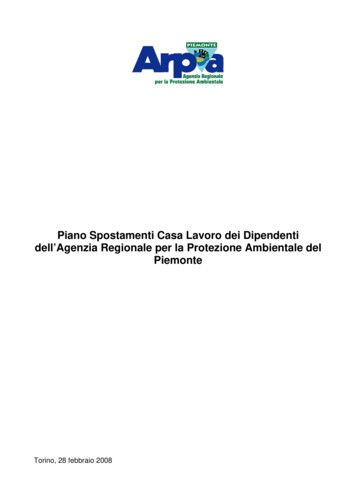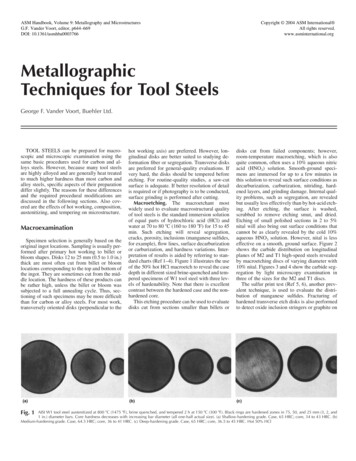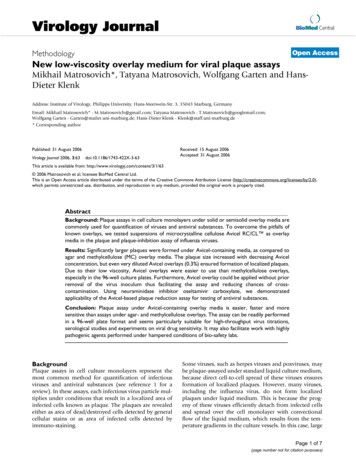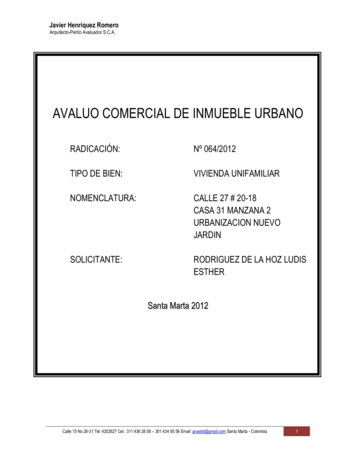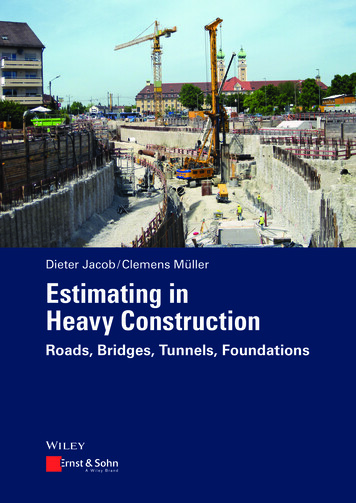
Transcription
Dieter Jacob / Clemens MüllerEstimating inHeavy ConstructionRoads, Bridges, Tunnels, Foundations
VIIForewordThere is no up-to-date English language textbook on heavy construction calculation / estimation, in contrast to building construction. This may be because this type ofconstruction often involves heavy construction machinery from Germany and Asiancountries. Therefore, I appreciate that such a textbook for contractors as well as clientshas been provided.This book can be used for US heavy construction, as well as heavy construction inAsia and developing countries. The examples are calculated in euros and can easily bechanged into USD. The examples have to be adapted to the local / regional conditionswith regard to wages and material costs. The sales tax / value added tax as used alsoneeds to be adapted.The book provides a good basis for estimation because all important cost categoriesare considered. The risks of different construction contracts are systematically evaluated with regard to risk distribution between owner and contractor. Specific risks, forinstance for joint ventures, are also considered. A systematic scheme for the calculation of interim interest is provided as well.The book differentiates between time-dependent and time-independent costs. This allows one to easily calculate the costs caused by delays. The initial strategy part of thebook considers the effect of different levels of capacity utilization and the cost / profitconsequences. The calculation / estimation is not presented as a deterministic process,but the book shows how this depends on strategic considerations, subjective factorsand stochastic characteristics. The book also demonstrates the application of cost estimating software.Prof. Dr. Herbert H. EinsteinProfessor of Civil and Environmental EngineeringMassachusetts Institute of TechnologyCambridge, MA 02139, USAfpref01.indd 704.10.2016 09:36:07
IXPrefaceIn contrast to building construction, there are only a few available English books onestimating in heavy construction projects, such as roads, bridges and specialized foundation engineering works for buildings. This book is based on our German estimatingbook, in which we have collected German examples. These real projects can also beapplied to the international market.The estimating is based on specific construction methods which are dependent on theboundary conditions, the machinery available and the quality and training of personnel.Be aware that estimating is always a stochastic process and cannot deliver a deterministic result. Reliable estimating is not only important for a contractor but also for a professional client who wants to have a rough overview of his cost situation, especially incivil engineering and underground construction. This is expensive, complicated workand one cannot simply measure square or cubic meters of living space as in standardized building engineering. One only has to think of related significant cost overrunsin a few recent large-scale projects to understand the need for a publication writtenexclusively for heavy construction estimating.We would especially like to thank all contributing heavy contractors such as StrabagGroßprojekte GmbH, VINCI, Heijmans Oevermann GmbH, BAUER AG and MatthäiBauunternehmen GmbH & Co. KG for their support.Freiberg, September 2016 fpref02.indd 9Dieter Jacob, Clemens Müller (Editors)04.10.2016 09:36:34
XI Table of contentsList of Authors. . . . . . . . . . . . . . . . . . . . . . . . . . . . . . . . . . . . . . . . . . . . . . . . . . . . . . . . . . . . . . . . . . . . . . . . . . . . . . . . . . . . . . . . . . . . . . . . . . . . . . . . . . . . . . . . . . .VForeword. . . . . . . . . . . . . . . . . . . . . . . . . . . . . . . . . . . . . . . . . . . . . . . . . . . . . . . . . . . . . . . . . . . . . . . . . . . . . . . . . . . . . . . . . . . . . . . . . . . . . . . . . . . . . . . . . . . . . . . . . . . . VIIPreface.IXList of Abbreviations. . . . . . . . . . . . . . . . . . . . . . . . . . . . . . . . . . . . . . . . . . . . . . . . . . . . . . . . . . . . . . . . . . . . . . . . . . . . . . . . . . . . . . . . . . . . . . . . . . . . . . . XIIIList of Figues. . . . . . . . . . . . . . . . . . . . . . . . . . . . . . . . . . . . . . . . . . . . . . . . . . . . . . . . . . . . . . . . . . . . . . . . . . . . . . . . . . . . . . . . . . . . . . . . . . . . . . . . . . . . . . . . . . . . . XVIIList of Tables. . . . . . . . . . . . . . . . . . . . . . . . . . . . . . . . . . . . . . . . . . . . . . . . . . . . . . . . . . . . . . . . . . . . . . . . . . . . . . . . . . . . . . . . . . . . . . . . . . . . . . . . . . . . . . . . . . . . . XXI11.11.21.3Strategy and estimating. . . . . . . . . . . . . . . . . . . . . . . . . . . . . . . . . . . . . . . . . . . . . . . . . . . . . . . . . . . . . . . . . . . . . . . . . . . . . . . . . .2Estimating costs in heavy construction. . . . . . . . . . . . . . . . . . . . . . . . . . . . . . . . . . . . . . . . . . . . . . . . . . . . . . 2.42.4.12.4.22.4.32.52.5.1ftoc.indd 11Sales and marketing strategies. . . . . . . . . . . . . . . . . . . . . . . . . . . . . . . . . . . . . . . . . . . . . . . . . . . . . . . . . . . . . . . . . . . . . . . . .Production and procurement strategies. . . . . . . . . . . . . . . . . . . . . . . . . . . . . . . . . . . . . . . . . . . . . . . . . . . . . . . . . . .Financing strategies. . . . . . . . . . . . . . . . . . . . . . . . . . . . . . . . . . . . . . . . . . . . . . . . . . . . . . . . . . . . . . . . . . . . . . . . . . . . . . . . . . . . . . . . . . .115811Foundations of construction business management. . . . . . . . . . . . . . . . . . . . . . . . . . . . . . . . . . . . . 11Estimating goals. . . . . . . . . . . . . . . . . . . . . . . . . . . . . . . . . . . . . . . . . . . . . . . . . . . . . . . . . . . . . . . . . . . . . . . . . . . . . . . . . . . . . . . . . . . . . . . . . 11Key financial cost terminology. . . . . . . . . . . . . . . . . . . . . . . . . . . . . . . . . . . . . . . . . . . . . . . . . . . . . . . . . . . . . . . . . . . . . . . . 12Types of construction contracts. . . . . . . . . . . . . . . . . . . . . . . . . . . . . . . . . . . . . . . . . . . . . . . . . . . . . . . . . . . . . . . . . . . . . . . 17Estimating methods. . . . . . . . . . . . . . . . . . . . . . . . . . . . . . . . . . . . . . . . . . . . . . . . . . . . . . . . . . . . . . . . . . . . . . . . . . . . . . . . . . . . . . . . . . . 20Further development of the pre-estimate. . . . . . . . . . . . . . . . . . . . . . . . . . . . . . . . . . . . . . . . . . . . . . . . . . . . . . . 24Coexistence of construction schedule, risk management plan andcapital commitment plan. . . . . . . . . . . . . . . . . . . . . . . . . . . . . . . . . . . . . . . . . . . . . . . . . . . . . . . . . . . . . . . . . . . . . . . . . . . . . . . . . . 26Liquidity planning and capital cost. . . . . . . . . . . . . . . . . . . . . . . . . . . . . . . . . . . . . . . . . . . . . . . . . . . . . . . . . . . . . . . . . 28Estimating of earthworks. . . . . . . . . . . . . . . . . . . . . . . . . . . . . . . . . . . . . . . . . . . . . . . . . . . . . . . . . . . . . . . . . . . . . . . . . . . . . . . . . . 33Introduction. . . . . . . . . . . . . . . . . . . . . . . . . . . . . . . . . . . . . . . . . . . . . . . . . . . . . . . . . . . . . . . . . . . . . . . . . . . . . . . . . . . . . . . . . . . . . . . . . . . . . . . . 33Construction site conditions. . . . . . . . . . . . . . . . . . . . . . . . . . . . . . . . . . . . . . . . . . . . . . . . . . . . . . . . . . . . . . . . . . . . . . . . . . . . . 34Bases of calculation. . . . . . . . . . . . . . . . . . . . . . . . . . . . . . . . . . . . . . . . . . . . . . . . . . . . . . . . . . . . . . . . . . . . . . . . . . . . . . . . . . . . . . . . . . . 36Preparatory work, systematization of the earthwork engineeringservices. . . . . . . . . . . . . . . . . . . . . . . . . . . . . . . . . . . . . . . . . . . . . . . . . . . . . . . . . . . . . . . . . . . . . . . . . . . . . . . . . . . . . . . . . . . . . . . . . . . . . . . . . . . . . . . . 43Corresponding factors of construction execution. . . . . . . . . . . . . . . . . . . . . . . . . . . . . . . . . . . . . . . . . 44Calculation of the partial activities. . . . . . . . . . . . . . . . . . . . . . . . . . . . . . . . . . . . . . . . . . . . . . . . . . . . . . . . . . . . . . . . . 45Conclusion. . . . . . . . . . . . . . . . . . . . . . . . . . . . . . . . . . . . . . . . . . . . . . . . . . . . . . . . . . . . . . . . . . . . . . . . . . . . . . . . . . . . . . . . . . . . . . . . . . . . . . . . . . 50Estimating in road construction. . . . . . . . . . . . . . . . . . . . . . . . . . . . . . . . . . . . . . . . . . . . . . . . . . . . . . . . . . . . . . . . . . . . . . . 51Construction specifications. . . . . . . . . . . . . . . . . . . . . . . . . . . . . . . . . . . . . . . . . . . . . . . . . . . . . . . . . . . . . . . . . . . . . . . . . . . . . . 51Direct costs of the partial activities. . . . . . . . . . . . . . . . . . . . . . . . . . . . . . . . . . . . . . . . . . . . . . . . . . . . . . . . . . . . . . . . . 52Overheads and other surcharges. . . . . . . . . . . . . . . . . . . . . . . . . . . . . . . . . . . . . . . . . . . . . . . . . . . . . . . . . . . . . . . . . . . . . . 53Calculation example. . . . . . . . . . . . . . . . . . . . . . . . . . . . . . . . . . . . . . . . . . . . . . . . . . . . . . . . . . . . . . . . . . . . . . . . . . . . . . . . . . . . . . . . . . 53Estimating in bridge construction. . . . . . . . . . . . . . . . . . . . . . . . . . . . . . . . . . . . . . . . . . . . . . . . . . . . . . . . . . . . . . . . . . . 65Basics. . . . . . . . . . . . . . . . . . . . . . . . . . . . . . . . . . . . . . . . . . . . . . . . . . . . . . . . . . . . . . . . . . . . . . . . . . . . . . . . . . . . . . . . . . . . . . . . . . . . . . . . . . . . . . . . . . 65Example – Steel composite bridge. . . . . . . . . . . . . . . . . . . . . . . . . . . . . . . . . . . . . . . . . . . . . . . . . . . . . . . . . . . . . . . . . . 67Example – Prestressed concrete bridge. . . . . . . . . . . . . . . . . . . . . . . . . . . . . . . . . . . . . . . . . . . . . . . . . . . . . . . . . . 89Estimating in tunnel construction. . . . . . . . . . . . . . . . . . . . . . . . . . . . . . . . . . . . . . . . . . . . . . . . . . . . . . . . . . . . . . . . . . . . 122Introduction. . . . . . . . . . . . . . . . . . . . . . . . . . . . . . . . . . . . . . . . . . . . . . . . . . . . . . . . . . . . . . . . . . . . . . . . . . . . . . . . . . . . . . . . . . . . . . . . . . . . . . . . 12204.10.2016 09:36:55
XII Table of ple – Cutting shield boring. . . . . . . . . . . . . . . . . . . . . . . . . . . . . . . . . . . . . . . . . . . . . . . . . . . . . . . . . . . . . . . . . . . . .Example of traditional tunnel construction. . . . . . . . . . . . . . . . . . . . . . . . . . . . . . . . . . . . . . . . . . . . . . . . . . . .Example – Floating assembly. . . . . . . . . . . . . . . . . . . . . . . . . . . . . . . . . . . . . . . . . . . . . . . . . . . . . . . . . . . . . . . . . . . . . . . . . .Costing and pricing. . . . . . . . . . . . . . . . . . . . . . . . . . . . . . . . . . . . . . . . . . . . . . . . . . . . . . . . . . . . . . . . . . . . . . . . . . . . . . . . . . . . . . . . . . .Estimating of foundation engineering works. . . . . . . . . . . . . . . . . . . . . . . . . . . . . . . . . . . . . . . . . . . . . . . . .Basics. . . . . . . . . . . . . . . . . . . . . . . . . . . . . . . . . . . . . . . . . . . . . . . . . . . . . . . . . . . . . . . . . . . . . . . . . . . . . . . . . . . . . . . . . . . . . . . . . . . . . . . . . . . . . . . . . .Costing and pricing. . . . . . . . . . . . . . . . . . . . . . . . . . . . . . . . . . . . . . . . . . . . . . . . . . . . . . . . . . . . . . . . . . . . . . . . . . . . . . . . . . . . . . . . . . .Examples. . . . . . . . . . . . . . . . . . . . . . . . . . . . . . . . . . . . . . . . . . . . . . . . . . . . . . . . . . . . . . . . . . . . . . . . . . . . . . . . . . . . . . . . . . . . . . . . . . . . . . . . . . . . .33.5.43.5.53.5.63.5.73.5.83.5.9Special aspects of the estimating process. . . . . . . . . . . . . . . . . . . . . . . . . . . . . . . . . . . . . . . . . . . . . . . . . . 205Claim management. . . . . . . . . . . . . . . . . . . . . . . . . . . . . . . . . . . . . . . . . . . . . . . . . . . . . . . . . . . . . . . . . . . . . . . . . . . . . . . . . . . . . . . . . . . . 205Introduction. . . . . . . . . . . . . . . . . . . . . . . . . . . . . . . . . . . . . . . . . . . . . . . . . . . . . . . . . . . . . . . . . . . . . . . . . . . . . . . . . . . . . . . . . . . . . . . . . . . . . . . . 205Contractual basics. . . . . . . . . . . . . . . . . . . . . . . . . . . . . . . . . . . . . . . . . . . . . . . . . . . . . . . . . . . . . . . . . . . . . . . . . . . . . . . . . . . . . . . . . . . . . . 205Chosen change orders during the construction process. . . . . . . . . . . . . . . . . . . . . . . . . . . . . . . 206Example calculation. . . . . . . . . . . . . . . . . . . . . . . . . . . . . . . . . . . . . . . . . . . . . . . . . . . . . . . . . . . . . . . . . . . . . . . . . . . . . . . . . . . . . . . . . . 206Construction in foreign countries. . . . . . . . . . . . . . . . . . . . . . . . . . . . . . . . . . . . . . . . . . . . . . . . . . . . . . . . . . . . . . . . . . . . 208Financial risks and dispute resolutions. . . . . . . . . . . . . . . . . . . . . . . . . . . . . . . . . . . . . . . . . . . . . . . . . . . . . . . . . . . 209Safeguarding foreign construction projects and export transactions . . . . . . . . . 211Hedging foreign exchange transactions. . . . . . . . . . . . . . . . . . . . . . . . . . . . . . . . . . . . . . . . . . . . . . . . . . . . . . . . . . 220Calculation of risks. . . . . . . . . . . . . . . . . . . . . . . . . . . . . . . . . . . . . . . . . . . . . . . . . . . . . . . . . . . . . . . . . . . . . . . . . . . . . . . . . . . . . . . . . . . . 220Major functional risk sectors. . . . . . . . . . . . . . . . . . . . . . . . . . . . . . . . . . . . . . . . . . . . . . . . . . . . . . . . . . . . . . . . . . . . . . . . . . . 221Typical risk sharing in life-cycle valuations of construction projects. . . . . . . . 225Cost accounting assessment of risks. . . . . . . . . . . . . . . . . . . . . . . . . . . . . . . . . . . . . . . . . . . . . . . . . . . . . . . . . . . . . . . 229Risk evaluation tools. . . . . . . . . . . . . . . . . . . . . . . . . . . . . . . . . . . . . . . . . . . . . . . . . . . . . . . . . . . . . . . . . . . . . . . . . . . . . . . . . . . . . . . . . 230Risk transfer. . . . . . . . . . . . . . . . . . . . . . . . . . . . . . . . . . . . . . . . . . . . . . . . . . . . . . . . . . . . . . . . . . . . . . . . . . . . . . . . . . . . . . . . . . . . . . . . . . . . . . . . 232Features of joint ventures. . . . . . . . . . . . . . . . . . . . . . . . . . . . . . . . . . . . . . . . . . . . . . . . . . . . . . . . . . . . . . . . . . . . . . . . . . . . . . . . . 233Basics. . . . . . . . . . . . . . . . . . . . . . . . . . . . . . . . . . . . . . . . . . . . . . . . . . . . . . . . . . . . . . . . . . . . . . . . . . . . . . . . . . . . . . . . . . . . . . . . . . . . . . . . . . . . . . . . . . 233Characteristics of the estimating process. . . . . . . . . . . . . . . . . . . . . . . . . . . . . . . . . . . . . . . . . . . . . . . . . . . . . . . 235Using estimating software. . . . . . . . . . . . . . . . . . . . . . . . . . . . . . . . . . . . . . . . . . . . . . . . . . . . . . . . . . . . . . . . . . . . . . . . . . . . . . . . 239Objectives and benefits . . . . . . . . . . . . . . . . . . . . . . . . . . . . . . . . . . . . . . . . . . . . . . . . . . . . . . . . . . . . . . . . . . . . . . . . . . . . . . . . . . . . 239Recourse to master data. . . . . . . . . . . . . . . . . . . . . . . . . . . . . . . . . . . . . . . . . . . . . . . . . . . . . . . . . . . . . . . . . . . . . . . . . . . . . . . . . . . . 239EDP evaluation. . . . . . . . . . . . . . . . . . . . . . . . . . . . . . . . . . . . . . . . . . . . . . . . . . . . . . . . . . . . . . . . . . . . . . . . . . . . . . . . . . . . . . . . . . . . . . . . . . 241Master data organization. . . . . . . . . . . . . . . . . . . . . . . . . . . . . . . . . . . . . . . . . . . . . . . . . . . . . . . . . . . . . . . . . . . . . . . . . . . . . . . . . . . 242EDP master data. . . . . . . . . . . . . . . . . . . . . . . . . . . . . . . . . . . . . . . . . . . . . . . . . . . . . . . . . . . . . . . . . . . . . . . . . . . . . . . . . . . . . . . . . . . . . . . . 246Example – Topsoil excavation and storage. . . . . . . . . . . . . . . . . . . . . . . . . . . . . . . . . . . . . . . . . . . . . . . . . . . . 248Example – Soil excavation and integration. . . . . . . . . . . . . . . . . . . . . . . . . . . . . . . . . . . . . . . . . . . . . . . . . . . . 249Approaching the market price. . . . . . . . . . . . . . . . . . . . . . . . . . . . . . . . . . . . . . . . . . . . . . . . . . . . . . . . . . . . . . . . . . . . . . . . . . 249Summary and conclusion. . . . . . . . . . . . . . . . . . . . . . . . . . . . . . . . . . . . . . . . . . . . . . . . . . . . . . . . . . . . . . . . . . . . . . . . . . . . . . . . . 251122143163169180180182183References . . . . . . . . . . . . . . . . . . . . . . . . . . . . . . . . . . . . . . . . . . . . . . . . . . . . . . . . . . . . . . . . . . . . . . . . . . . . . . . . . . . . . . . . . . . . . . . . . . . . . . . . . . . . . . . . . . . . . . . . 253Indexftoc.indd 12.25704.10.2016 09:36:55
11 2Estimating costs in heavy construction2.1Foundations of construction business management2.1.1Estimating goalsThe cost estimate is structured according to Figure 2.1:Figure 2.1 Cost estimate structure before and after order placement1)The goal of forecasting is to determine the production cost basis of a construction pro ject with respect to the processing costs, including all capital costs.2) This is used asthe baseline for negotiating prices with the potential customer.In our financial system the price is determined by the market and therefore is not di rectly related to the production cost basis for a product. Management thus requires fur ther accounting information for the negotiation of prices, for instance the lowest pricelimit or liquidity costs. In addition, due to “target costing”, this preliminary, projectedcalculation adds to the importance of the retrograde calculation.When planning target costs, one starts with the market price and subtracts what indi vidual project components may cost according to the predominant market price.Time-variable costs also remain important. The time-dependent costs are decisive andresult from the construction plan, which takes the form of a time-performance diagram.A further goal of forecasting could be to obtain information about the prospective liquid ity development of a project before signing the contract. This may be done in order torecognize the need for liquidity - or excess liquidity - and to determine financing costs.1) In accordance with Drees / Paul (2015), p. 20.2) Cf. Hauptverband der Deutschen Bauindustrie e. V. / Zentralverband des Deutschen Baugewerbes e. V. (Ed.) (2001), p. 30.Estimating in Heavy Construction. 1st Edition. Jacob, Müller (Eds.) 2017 Ernst & Sohn GmbH & Co. KG. Published 2017 by Ernst & Sohn GmbH & Co. KG.ch02.indd 1104.10.2016 09:34:41
12 2.1.22 Estimating costs in heavy constructionKey financial cost terminology2.1.2.1 Delimitation of costs and expensesIt is necessary for the terms “total expenses of the financial accounting” and “totalcosts of the management accounting” to be clearly separated (cf. Figure 2.2).3)Figure 2.2 Demarcation of the terms expenses and costs4)The total expenses consist of non-operating expenses and operating expenses. Thenon-operating expenses relate to (1) other periods (2) external expenses or (3) extraor dinary expenses. The expenses relating to other periods correspond to the expense ofprevious business years, for example, additional tax payments. External expenses arisethrough the pursuit of non-operational goals (e. g. charity). Expenses that are usuallynot expected in the context of ordinary operational procedures (e. g. fire damage) be long to extraordinary expenses.The part of the operating expense that is calculated as being equal to the costs re presents the basic costs in the management accounting. Examples of this include, butare not limited to, the consumption of construction materials, wages, salaries, or sub contractor expenses.The part of the operating expense that is calculated as being different to the costs con stitutes the outlay costs (i. e. imputed instead of balance sheet depreciation) in internalaccounting. The costs not faced with coinciding expenses are referred to as additionalcosts (i. e. imputed management wages, interest payments on equity, etc.). Outlay andadditional costs constitute the imputed costs. Together with the basic costs, these con stitute the total costs.3) The following parts are excerpts from Jacob / Winter / Stuhr (2008), p. 1112.4) In accordance with Eisele (2011).ch02.indd 1204.10.2016 09:34:41
2.1 Foundations of construction business management 13Finally, the operating expense and the running costs only differ with regard to outlayand additional costs. This is very important for management, because the period costsused by management must be, to the greatest possible extent, equal the operating ex pense of the financial accounting (cross-check by offsetting and reconciliation).2.1.2.2 Direct costs and indirect costsIn the estimating process it is exceptionally important to differentiate costs accordingto their imputability.5) Therefore, direct costs and indirect costs can be differentiated.All costs that can be directly attributed to specific cost units (e. g. building part), be long to the direct costs. Direct costs are used in cost type accounting and are assignedto a cost object. A cost allocation across multiple cost objects cannot occur. The typesof costs that can only indirectly be attributed to a cost object by way of redistribution orremuneration are considered non-costs. The artificial indirect costs constitute a uniquesituation. These can theoretically be directly accounted to a cost object, but are never theless treated as indirect costs for financial reasons.6) Examples could be additionalmaterials or certain small materials (i. e. screws).2.1.2.3 Time variable –time fixed costsProper costing of a planned construction project necessitates the differentiation ofthe prospective costs according to their chronological order.7) While some types ofcosts change according to the duration of the construction project, others are set onlyonce and are hence independent of the construction time. Thus, classifications of bothtime-variable and time-fixed costs can be made.Time-variable costs of a construction site include:8)–– Contingency costs9) (equipment, special plants and machines, accommodation,trailer, contractor’s shed, vehicles, fixtures, office equipment, scaffolding, frame work and pit lining supplies, external and safety scaffolding, security facilities, andtraffic control installations)–– Operational expenses (equipment, special plants and machines, accommodation,trailer, vehicles)–– The expense of the site management (supervision and coordination)10) (salaries,telephone, postage, office supplies, automobile and travel costs, hospitality and ad vertisements)–– The general construction costs (auxiliary e. g. for security staff, surveying assistants,supply costs for the construction site, maintenance costs of paths, squares, roads and5) The following remarks are extracted from Jacob / Winter / Stuhr (2008), p. 1102 f.6) Cf. Götze (2010), p. 20.7) The following remarks are extracted from Jacob / Winter / Stuhr (2008), p. 1103 f.8) In accordance with Drees / Paul (2015), p. 90.9) In the case of a longer construction time the construction project has to be charged with a higher proportion of contin gency costs for the operating supplies used.10) In the event of an extension of the construction time, the construction project will be burdened with a higher pro portion of labor costs.ch02.indd 1304.10.2016 09:34:41
14 2 Estimating costs in heavy constructionfences, lease and rent e. g. for accommodations, offices, construction site facilitylocations, time variable costs)Time-fixed costs of a construction site include:11)–– Time-fixed costs of the construction site facilities (loading costs, freight costs, assemblyand disassembly cost for equipment, accommodation, site trailers, trailers, telecommu nications, water supply / sewage disposal, access, paths, fences, work bays and storageplace, all kinds of scaffolding, security facilities and traffic control installations)–– Costs of the construction site equipment (auxiliary material; small agriculturalequipment and tools, office equipment, accommodation, sanitation facilities, so faras they are not already included under contingency costs)–– Engineering processing and technical control (structural editing, work preparation,construction material tests, soil analysis)–– Construction risks (unique risks arising from the construction process which are con fined to the construction project, e. g. adverse weather, high and low water, limitedconstruction times leading to time limit violations and subsequent contractual penal ties, the implementation of new construction methods; insurance covering all uniquerisks arising from the construction process throughout the project’s operations)–– Additional charges (abnormal construction interest; license fees, working groupcosts for both technical and business management, additional provisions for winterconstruction, and other individual costs)–– Disposal of construction waste and / or construction material (excavated earth, con struction rubble, construction debris, road surface material, special waste e. g. colo rants and packages of paints, mineral oil etc.)A differentiation of the costs according to their chronological behavior is also nec essary when estimating special cases, namely cases regarding changes in the costrange after the contract terminates and disruptions of the construction schedule (cf. section 3.1). In conjunction with estimating special cases, which may cause a reductionin the contractually established scope of performance, the extent to which costs areremanant should also be examined. Cost remanence indicates that the costs decreasemore slowly as a result of a decrease in activity than they rise as a result of an increasein activity. It follows that there are certain costs that are not extractable in the shortterm. An example of this is the use of special construction materials that the contractorhas already purchased, which, as a result of the reduction in the scope of performance,are no longer needed to their full extent and are also unlikely to be utilized by construc tion projects in the foreseeable future.2.1.2.4 Company related – project related costsCompany related costs, i. e. those costs that originate from all operations of the com pany, which are attributed to the establishment’s location and the central headquartersinclude:12)11) In accordance with Drees / Paul (2015), p. 90.12) Jacob / Winter / Stuhr (2008), p. 1104.ch02.indd 1404.10.2016 09:34:41
2.1 Foundations of construction business management 15–– Short-term non-degradable costs that guarantee the readiness of production, e. g.wages and salaries of the senior staff (including legislation and agreed social costs),rental costs, depreciation and interest costs of constructions and equipment–– Cost of lighting, heating, cleaning, office equipment, phone, marketing, legal ex penses, and consulting fees etc.–– Cost of the construction yard, repair workshop, vehicle fleet–– Taxation or public charges–– Contributions to organisations–– Insurance, as far as it does not concern individual construction projects,–– Transaction costs (costs of initiation, agreement, settlement, alignment, and auditingof contractual relations), including the costs of unsuccessful acquisition attempts–– Cost of enterprise-related risk–– Costs of warranties and sureties (basic fee)–– Imputed entrepreneurs’ salaryProject-related costs are especially contributed to:13)–– Cost of construction materials, auxiliary construction materials, and operating sup plies–– Cost of third-party work and subcontractors–– Costs of loading, freight, assembly, modification, and dismantling of the companyequipment–– Transportation costs of construction site supplies–– Cost of energy, water, waste water, and telecommunications–– Costs of the construction, maintenance and repair of entry-ways, paths, barricades(e. g. fences), storage facilities, cost of traffic security–– Miscellaneous costs from leasing and renting–– Cost of construction waste and / or construction material disposal–– Costs arising from project-specific risks–– Cost of project-specific insurance–– Cost of guarantees and sureties, in so far as they are performance dependent,–– Cost of weather-related compensation–– Cost of legal project auditing–– Cost of interim financing for the construction project related loan costs,–– Other cos
In contrast to building construction, there are only a few available English books on estimating in heavy construction projects, such as roads, bridges and specialized foun-dation engineering works for buildings. This book is based on our German estimating book, in which we have c


